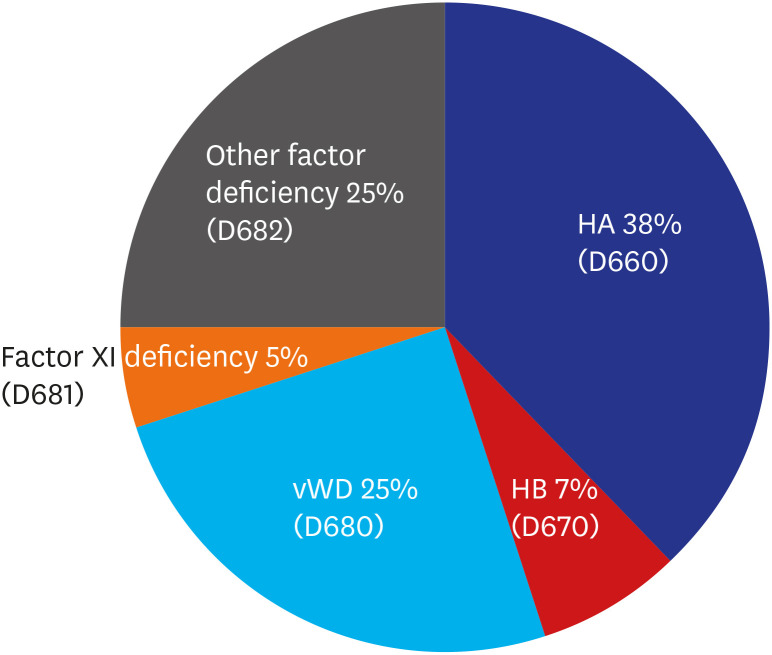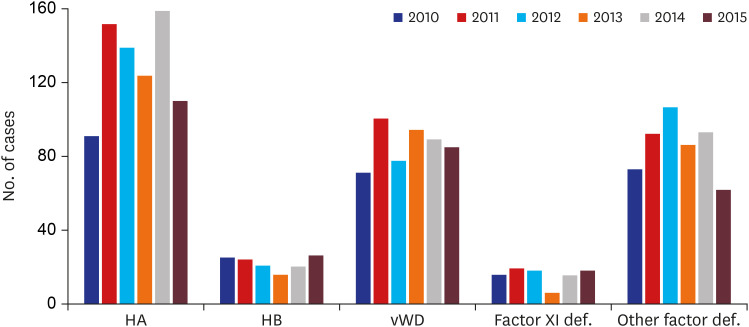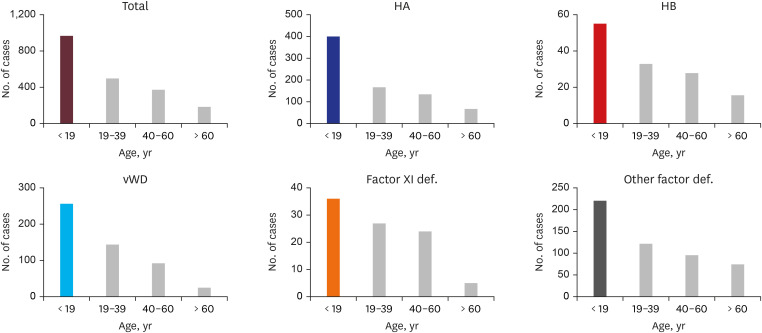J Korean Med Sci.
2020 Oct;35(39):e350. 10.3346/jkms.2020.35.e350.
Epidemiology of Congenital Bleeding Disorders: a Nationwide Populationbased Korean Study
- Affiliations
-
- 1Department of Pediatrics, Kyung Hee University School of Medicine, Seoul, Korea
- 2Department of Laboratory Medicine, Kyung Hee University School of Medicine, Seoul, Korea
- 3Seegene Medical Foundation, Seoul, Korea
- 4Department of Internal Medicine, Seoul National University College of Medicine, National University Hospital, Seoul, Korea
- 5Research Institute, National Health Insurance Service Ilsan Hospital, Goyang, Korea
- 6Department of Pediatrics, Chosun University Hospital, Gwangju, Korea
- 7Department of Laboratory Medicine, National Health Insurance Service Ilsan Hospital, Goyang, Korea
- KMID: 2507611
- DOI: http://doi.org/10.3346/jkms.2020.35.e350
Abstract
- Background
Except for data in the Korea Hemophilia Foundation Registry, little is known of the epidemiology of congenital bleeding disorders in Korea.
Methods
Data were obtained from the Korean Health Insurance Review and Assessment Service (HIRA) database.
Results
From 2010 to 2015, there were 2,029 patients with congenital bleeding disorders in the Korean HIRA database: 38% (n = 775) of these patients had hemophilia A (HA), 25% (n = 517) had von Willebrand disease (vWD), 7% (n = 132) had hemophilia B (HB), and 25% (n = 513) had less common factor deficiencies. The estimated age-standardized incidence rate (ASR) of HA and HB was 1.78–3.15/100,000 and 0.31–0.51/100,000, respectively. That of vWD was 1.38–1.95/100,000. The estimated ASR of HA showed increase over time though the number of new patients did not increase. Most patients with congenital bleeding disorders were younger than 19 years old (47.8%), and most were registered in Gyeonggi (22.1%) and Seoul (19.2%).
Conclusion
This is the first nationwide population-based study of congenital bleeding disorders in Korea. This study provides data that will enable more accurate estimations of patients with vWD. This information will help advance the comprehensive care of congenital bleeding disorders. We need to continue to obtain more detailed information on patients to improve the management of these diseases.
Keyword
Figure
Reference
-
1. Mannucci PM, Tuddenham EG. The hemophilias--from royal genes to gene therapy. N Engl J Med. 2001; 344(23):1773–1779. PMID: 11396445.2. Mannucci PM, Duga S, Peyvandi F. Recessively inherited coagulation disorders. Blood. 2004; 104(5):1243–1252. PMID: 15138162.
Article3. Korea Hemophilia Foundation. 2018 annual report Korea Hemophilia Foundation. Updated 2019. http://www.kohem.org/_data/board_list_file/8/2019/1909191104301.pdf.4. World Federation of Hemophilia. Report on the annual global survey 2018. Updated 2019. Accessed February 15, 2020. http://www1.wfh.org/publications/files/pdf-1731.pdf.5. Kim DS. Introduction: health of the health care system in Korea. Soc Work Public Health. 2010; 25(2):127–141. PMID: 20391257.
Article6. Kim DS. Special issue on the national health care system of South Korea. Soc Work Public Health. 2010; 25(2):125–126. PMID: 20391256.7. Park YT, Yoon JS, Speedie SM, Yoon H, Lee J. Health insurance claim review using information technologies. Healthc Inform Res. 2012; 18(3):215–224. PMID: 23115745.
Article8. Korean Statistical Information Services. Beneficiaries by city/province, age and gender (health insurance & medical aid). Accessed December 17, 2016. http://kosis.kr/.9. Kim DH, Kim SK, Park SK, Yoo KY, Hwang TJ, Choi YM. Korea hemophilia foundation registry trends 1991–2012: patient registry, demographics, health services utilization. Haemophilia. 2015; 21(6):e479–80. PMID: 26212599.
Article10. Yoo KY, Kim SK, Kwon SS, Park SK, Yoon HJ, Lee KS, et al. Life expectancy of Korean haemophiliacs, 1991-2012. Haemophilia. 2014; 20(4):e356–8. PMID: 24948408.
Article11. Rodeghiero F, Castaman G, Dini E. Epidemiological investigation of the prevalence of von Willebrand’s disease. Blood. 1987; 69(2):454–459. PMID: 3492222.
Article12. Srivastava A, Rodeghiero F. Epidemiology of von Willebrand disease in developing countries. Semin Thromb Hemost. 2005; 31(5):569–576. PMID: 16276466.
Article13. Leebeek FW, Eikenboom JC. Von Willebrand's disease. N Engl J Med. 2016; 375(21):2067–2080. PMID: 27959741.
Article14. Werner EJ, Broxson EH, Tucker EL, Giroux DS, Shults J, Abshire TC. Prevalence of von Willebrand disease in children: a multiethnic study. J Pediatr. 1993; 123(6):893–898. PMID: 8229521.
Article15. Giampaolo A, Abbonizio F, Arcieri R, Hassan HJ. Italian registry of congenital bleeding disorders. J Clin Med. 2017; 6(3):34–41.
Article16. Tu TC, Liou WS, Chou TY, Lin TK, Lee CF, Chen JD, et al. Prevalence, incidence, and factor concentrate usage trends of hemophiliacs in Taiwan. Yonsei Med J. 2013; 54(1):71–80. PMID: 23225801.
Article17. Kang P, Fang Y, Cheng Y, Zhang X, Wang J, Li H, et al. Analysis of haemophilia case information of Shandong Province in China: data from 2010 to 2017. Haemophilia. 2019; 25(3):e209–11. PMID: 30888100.
Article18. Elhadi I, Saed E, Elhory O, Abdallah S, Adam I. Rare clotting factor deficiency among Sudanese children. Blood Coagul Fibrinolysis. 2019; 30(6):277–280. PMID: 31259776.
Article
- Full Text Links
- Actions
-
Cited
- CITED
-
- Close
- Share
- Similar articles
-
- PREFACE
- Epidemiology and Long-Term Adverse Outcomes in Korean Patients with Congenital Adrenal Hyperplasia: A Nationwide Study
- Incidence, Comorbidity, and Mortality of Primary Congenital Glaucoma in Korea from 2001 to 2015: A Nationwide Populationbased Study
- Disorders in Hemostasis
- Epidemiology of Ankle Fractures in Korea: A Nationwide PopulationBased Study




